| Fire damages historic Rosegill |
| This article appeared in the July 28, 1977 issue of the Southside Sentinel |
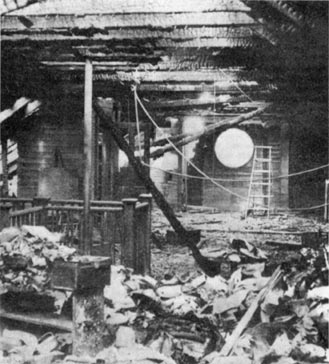
Ruins at Rosegill
The attic and roof at Rosegill were charred and almost completely
destroyed in last Thursday night's fire, as this "morning
after" picture shows. Books and clothing belonging to Dr.
Charles Longsworth lie in a rubble on the attic floor.
|
Fire damages historic Rosegill An attic fire and the estimated 45,000 gallons of water used to contain it caused extensive damage last Thursday to Rosegill, an historic 17th century home just outside Urbanna. Quick action by some 100 volunteers... firemen and other citizens... plus a ready supply of water from a swimming pool just yards from the structure were credited with limiting the damage and possibly saving the home from complete destruction. Strother and Alfred Scott, owners of the historic estate, commended firemen and other volunteers for their work. Both were at work cleaning up fire debris Friday and said they would begin work to restore the large home, established in 1649. The entire attic of Rosegill was gutted by flames and most of the roof was destroyed. Ceilings in the second floor were also damaged in several places and some water reached each room in the structure. Firemen have indicated water damages will be hard to estimate until the water dries but a State Fire Marshal on the scene about 3:30 a.m. Friday estimated damages at $50,000. He said the fire was caused by the overloading of an electrical circuit in the attic. The fire was discovered about 9:30 p.m. last Thursday by Mrs. David Ginter, her son, David Jr., and a friend who was staying with David. Mr. And Mrs. Ginter had subleased the house for the summer. Mrs. Ray Lewis, who lives in a former dependency next door, said she was notified of the fire by the Ginters' son and called Middlesex Emergency. |
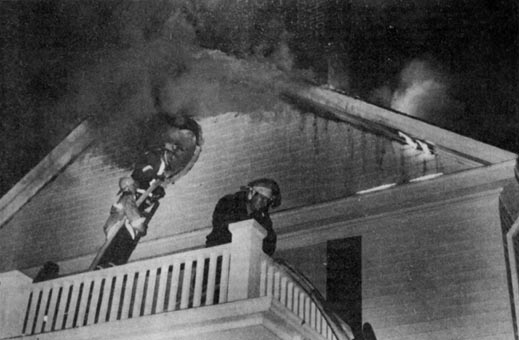
Fire in the eaves!
Firemen aim their hoses through an attic window at Rosegill, trying
to extinguish flames
which damages the historic home last Thursday night. Because the
roof was high and
ladders were short, firemen were hampered in their efforts but
managed to save the building.
|
The Middlesex Volunteer Fire Department in Urbanna received the call at 9:38 p.m. and the first fire truck was on the scene at 9:42 p.m. Urbanna fire chief William Thrift said the fire had probably been smoldering some 30 minutes before it was discovered, since a large attic fan was still operating and carrying much of the smoke out of the house. Thrift soon called for additional equipment and eventually 13 pieces of fire equipment reported to help with the blaze. Initially most of the flames were confined to an area surrounding the overheated wiring but the fire soon spread throughout the pine-paneled attic which covers the length of the building. Firemen were hampered by the height of the roof, which was too high for most ladders, but gained access to the blaze from portico roofs on all four sides of the home. As units from the Hartfield and Lower Middlesex Fire Departments and the Water View branch of the Middlesex Fire Department arrived, firemen immediately began pumping from the Rosegill swimming pock on the north side of the house. Tanker trucks from Water View and Hartfield supplied hoses on the south side of the house, refilling several times at a high capacity hydrant at nearby Barnhardt Farms. A maze of fire hoses soon wormed their way across the normally quiet and expansive lawn and spotlights from fire engines were trained on all parts of the building, creating a semblance of daylight around the "summer home of Colonial governors." Meanwhile, several anxious Urbanna area citizens gathered near Payne's crabhouse on Urbanna Creek to watch the activity and many more drove across the bridge to Rosegill to offer assistance. As firemen worked to extinguish the fire, teenagers' and senior citizens alike began to remove furniture from the house, placing chairs, tables, lamps, chests-everything but mattresses, out in the lawn away from the fire. Other volunteers with pickup trucks later moved the furniture to a storage barn and some was carried into Mrs. Lewis' home. Most of the furnishings belong to Dr. Charles Longsworth, recently named president of Colonial Williamsburg, who had leased the home and planned to move there in September. He had subleased the home to Mr. And Mrs. Ginter of Pittsburgh for the summer months. Most of the furniture escaped serious damage but numerous books, some sports equipment, and some clothing belonging to Dr. Longsworth's six daughters were stored in the attic and almost totally destroyed. As firemen struggled to reach the hot attic, the fire reached its most serious point about 11 p.m. when flames began shooting from several sections of the high roof and out of the eaves. Calls for more help from the White Stone Fire Department and the Tappahannock Fire Department, which has a 150 ft. ladder truck, were placed. Meanwhile, with 8 pieces of equipment already on the scene, firemen continued to pump thousands of gallons of water through gaping holes in the roof and through windows in the eaves. Those nearest the attic had to seek relief because of extreme temperatures and salt was passed around to offset heavy perspiration losses. The Central Middlesex Rescue Squad stood by and treated several cuts from broken glass. The Urbanna firemen's auxiliary also set up a relief station offering water and later iced tea and sandwiches for the fire fighters. After battling the blaze for almost three hours, firemen finally had the flames under control about 12:30 a.m. Two units from White Stone arrived shortly before that and three units from Tappahannock joined them. The large ladder truck was used briefly to reach the still-smoldering west eave. Most fire equipment left the scene about 1:30 a. m. although some firemen remained to watch for additional sparks until almost- 4 a.m. Rosegill was named a Virginia Historic Landmark in 1972 and it has been ranked among the oldest and most historic estates in America. Patented in 1649 by Ralph Wormeley I, it originally contained 3200 acres and remained in the Wormeley family until 1806. History notes that in 1686 the estate included some 20 houses, one of them used as a summer residence of the Colonial Governor, Lord Howard of Effingham. Officials believe the present buildings were constructed between 1730-1750, however, and extensive alterations about 1850 gave the main house its present aspect. U.S. Senator J. Henry Cochran of Pennsylvania owned the home from 1901-1924 and the Scotts bought the property two years ago from the widow of Sidney L. Shannon Sr., an Eastern Airlines executive who acquired it in 1944. |
Scenes at the Rosegill Fire
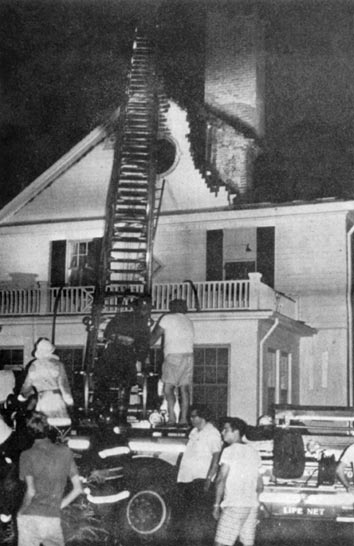
|
With most of the west eave of Rosegill already
burned away, Tappahannock firemen maneuver |
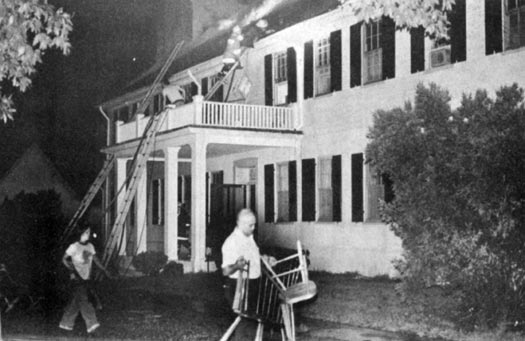
|
As an intermittent, misty rain fell during the
Rosegill fire, area citizens began moving furniture |
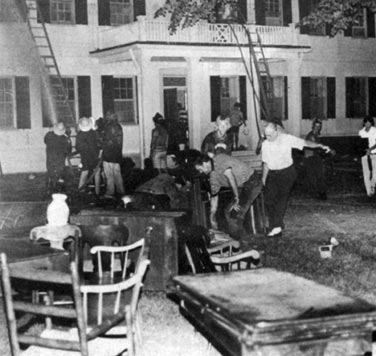
|
As firemen pour water on Rosegill in the background,
other volunteers struggle with |
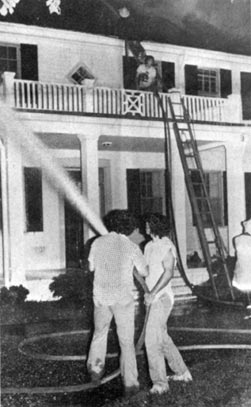
|
Because of a shortage of long ladders, some firemen
fought |
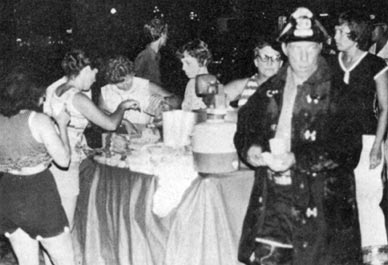
|
After battling the Rosegill fire nearly 3 hours,
firemen welcomed cold drinks and |
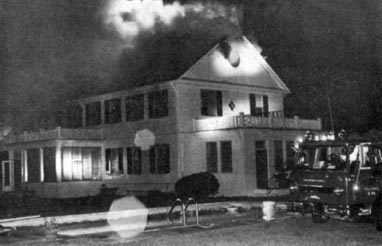
|
Credited with saving Rosegill from total destruction
by fire, firemen |
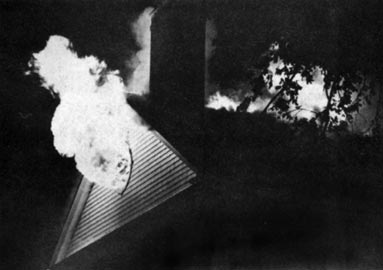
|
At its most serious point, fire billows from
the roof and attic |
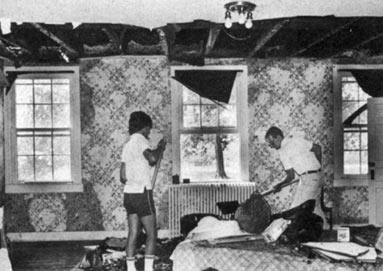
|
Cleaning house at Rosegill last Friday was best
done with shovels as the two men above begin to remove |
|
|